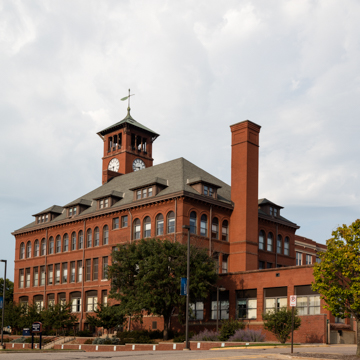James Huff Stout, son of a Knapp, Stout and Company partner, became excited by the pioneer manual-training schools that were opening in major midwestern cities. In 1893, he funded construction of Stout Manual Training School, which offered courses in ironwork, woodwork, domestic science, drafting, and other vocations. He also persuaded the school board to integrate manual training into the primary- and secondary-level curricula, making Menomonie the nation’s first school district to do so.
After a fire in 1897 destroyed the first building, Stout paid for a new red brick Industrial Arts Building. Each story has its own window treatment—segmental arches on the first floor, paired rectangular openings on the second, and round-arched windows with a continuous lintel on the third. Attic dormers huddle against the sides of the hipped roof. What makes the building a landmark is its soaring seven-story tower, whose upper two levels are corbeled on all sides, similar to those of civic buildings in medieval Italy. Clock faces on the sixth level give way to an open belfry on the seventh.
The school, later called Stout Institute, became a state college in 1926, a university in the 1950s, and part of the University of Wisconsin system in 1970.


